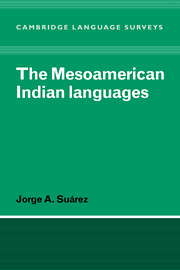Book contents
- Frontmatter
- Contents
- List of illustrations
- List of tables
- Preface
- Notational conventions
- Map 1 Present-day distribution of Mesoamerican Indian languages
- Table 1 Classification of Mesoamerican Indian languages and index to map 1
- 1 The study of Mesoamerican Indian languages
- 2 Dialects, languages and linguistic families
- 3 Phonology I
- 4 Phonology II
- 5 Morphology I
- 6 Morphology II
- 7 Syntax I
- 8 Syntax II
- 9 Preconquest literary traditions
- 10 The prehistory of Mesoamerican Indian languages
- 11 Indian languages after the conquest
- Appendix: Sources for sentences quoted in chapters 7 and 8
- References
- Language index
- Subject index
- Frontmatter
- Contents
- List of illustrations
- List of tables
- Preface
- Notational conventions
- Map 1 Present-day distribution of Mesoamerican Indian languages
- Table 1 Classification of Mesoamerican Indian languages and index to map 1
- 1 The study of Mesoamerican Indian languages
- 2 Dialects, languages and linguistic families
- 3 Phonology I
- 4 Phonology II
- 5 Morphology I
- 6 Morphology II
- 7 Syntax I
- 8 Syntax II
- 9 Preconquest literary traditions
- 10 The prehistory of Mesoamerican Indian languages
- 11 Indian languages after the conquest
- Appendix: Sources for sentences quoted in chapters 7 and 8
- References
- Language index
- Subject index
Summary
The phonemic systems of Mesoamerican languages show considerable diversity with regard to the number of contrasting units, less with regard to the types of contrasting features, and in general they offer few typologically uncommon characteristics.
In the present survey phonemes which occur only in Spanish loanwords will be excluded. There are various reasons for this: (1) these elements constitute relatively recent additions and can be identified as such with certainty, and their exclusion therefore helps to emphasize differences and similarities which are due, insofar as we can determine it, to internal developments of the native systems; (2) even within a single dialect, speakers vary in the use of non-adapted Spanish loanwords, and therefore any listing of these phonemes in a chart would give a false picture of the phenomenon which is basically variable; (3) a phonemic chart including borrowed phonemes might also give a false picture since in many cases there are in fact two coexisting phonemic systems. However, the changes introduced through Spanish loanwords (treated briefly in 3.1.6) will be of interest in relation to some of the topics dealt with in chapter 10.
A few remarks are in order about the way phonemic systems will be represented in charts and the terminology used. Rows representing manners of articulation and columns which represent positions of articulation will be referred to as series and orders respectively.
- Type
- Chapter
- Information
- The Mesoamerican Indian Languages , pp. 30 - 43Publisher: Cambridge University PressPrint publication year: 1983



